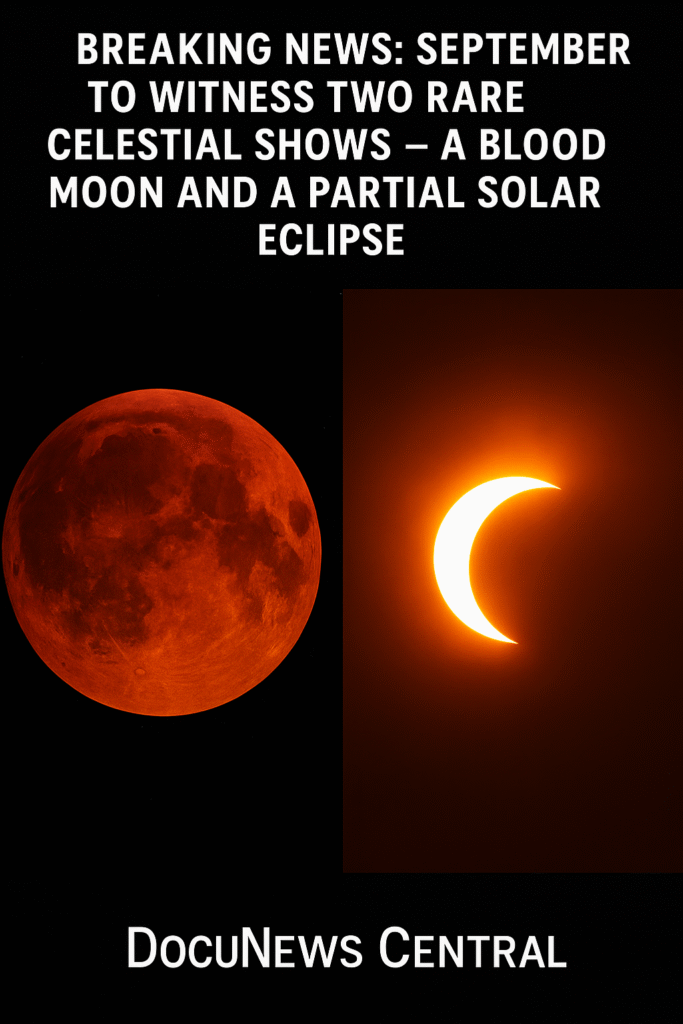
🌕 Breaking News: September to Witness Two Rare Celestial Shows – A Blood Moon and a Partial Solar Eclipse
September 2025 is shaping up to be a month for the history books as the heavens put on two awe-inspiring displays: a Total Lunar Eclipse — popularly called a “Blood Moon” — and a dramatic Partial Solar Eclipse. Stargazers, scientists, and ordinary skywatchers alike are bracing for nights and days filled with cosmic wonder.
🔴 SEPTEMBER 7–8: THE BLOOD MOON ECLIPSE – WHEN NIGHT TURNS RED
The opening act arrives on the night of September 7, stretching into the early hours of September 8, 2025, when the Moon will undergo a Total Lunar Eclipse. During this event, the Earth will position itself directly between the Sun and the Moon, casting its shadow across the lunar surface.
But unlike ordinary shadows, this one carries a fiery twist. Instead of disappearing into darkness, the Moon will glow an otherworldly deep red or copper color. This happens because Earth’s atmosphere bends sunlight around its edges. While the blue wavelengths scatter, the red and orange hues filter through — painting the Moon in dramatic crimson shades.
Astronomers estimate the total eclipse phase will last around 82 minutes — long enough for observers to soak in every second of this celestial transformation.
🌍 WHO WILL SEE IT BEST?
Not everyone will be lucky enough to catch this Blood Moon. It will be most visible to Asia, Africa, Australia, Europe, and Antarctica. Sadly, those in North and South America will miss this particular show.
For those who can watch, the best advice is simple: find an open sky, free of city lights, and just look up. No telescope, no filters, no binoculars — just the naked eye is enough to appreciate one of nature’s greatest free spectacles.
🏺 CULTURAL AND HISTORICAL SIGNIFICANCE OF BLOOD MOONS
Across centuries and civilizations, Blood Moons have stirred imaginations. In some cultures, they were seen as omens of war or disaster, while in others, they symbolized renewal and change. Ancient Mesopotamians believed a lunar eclipse was an attack on the Moon itself, prompting rituals to protect their kings.
In more recent history, many religious and cultural groups have woven Blood Moons into prophecies or legends. Today, while science has stripped away the fear, the sense of mystery and awe remains. For millions, witnessing the Moon turn red still sparks a deep emotional response — a reminder of humanity’s smallness in the vast universe.
☀️ SEPTEMBER 21: THE PARTIAL SOLAR ECLIPSE – A BITE OUT OF THE SUN
If the Blood Moon feels dramatic, then just two weeks later, the Sun itself will take center stage. On September 21, 2025, skywatchers in parts of the Southern Hemisphere will witness a Partial Solar Eclipse.
In this event, the Moon will slide between Earth and the Sun, but not perfectly aligned. Instead of completely blocking the solar disk, the Moon will take a “bite” out of the Sun, creating a fiery crescent shape. Depending on your location, this could look like the Sun being carved into a glowing arc at sunrise or sunset — a sight both eerie and beautiful.
🌏 WHERE WILL IT BE SEEN?
This eclipse will be visible in New Zealand, eastern Australia, the South Pacific islands, and parts of Antarctica. Astronomers note that New Zealanders will enjoy the deepest view, with the Moon covering up to 72% of the Sun’s disk at maximum obscuration.
The timing is particularly dramatic because, in some regions, the eclipse will coincide with sunrise or sunset. Imagine waking up to a dawn where the Sun rises not as a full circle, but as a glowing golden crescent. That image alone promises to fill social media feeds with unforgettable photos.
⚠️ SOLAR ECLIPSE SAFETY – WHY EYE PROTECTION IS CRUCIAL
Unlike lunar eclipses, which are safe to view with the naked eye, solar eclipses are dangerous if watched directly. Looking at the Sun without proper protection can cause permanent eye damage or blindness.
Astronomers and health experts emphasize the use of certified solar eclipse glasses or handheld solar filters. Regular sunglasses — even very dark ones — are not safe. Some viewers may also use special telescopes fitted with solar filters, or indirect methods such as pinhole projectors to safely track the Sun’s shadow play.
For schools, science clubs, and astronomy groups, this event is expected to spark hands-on learning sessions and viewing parties.
🔭 THE SCIENCE BEHIND THE WONDERS
Both lunar and solar eclipses are powerful demonstrations of cosmic alignment.
A lunar eclipse occurs when Earth blocks sunlight from reaching the Moon, casting its shadow.
A solar eclipse happens when the Moon blocks sunlight from reaching Earth, casting a shadow on parts of our planet.
Though predictable with modern astronomy, they remain rare treats in any given location, because they require precise orbital alignments. For 2025, having both a Total Lunar Eclipse and a Partial Solar Eclipse within two weeks makes September especially remarkable.
🌌 WHY THESE EVENTS CAPTURE OUR HEARTS
Beyond science, eclipses have an undeniable emotional pull. They remind us that we are part of a much larger cosmic dance — a tiny planet orbiting one star in a vast universe.
When the Moon blushes red or the Sun is bitten into a crescent, people from every culture and background pause. Social divides fade, replaced by collective awe. Families gather outside, children stay up past bedtime, and millions worldwide point cameras skyward.
In many ways, these events unite humanity in a shared moment of wonder — one of the few times we all truly look up together.
📌 FINAL SKYWATCHING GUIDE
For the Blood Moon (Sept 7–8):
Just step outside. No gear required. Best seen under dark skies away from city lights.
For the Solar Eclipse (Sept 21):
Use eclipse glasses, solar filters, or pinhole projection. Never look at the Sun directly with the naked eye.
Photography tip: A smartphone camera may capture the events, but using a tripod or telescope with filters will yield stunning results.
✨ SEPTEMBER 2025 – A MONTH OF COSMIC WONDERS
In a world often filled with distractions, September 2025 offers a chance to reconnect with the skies. First, the Moon will glow red, echoing ancient myths. Then, the Sun will dim into a crescent, etching fiery arcs across dawn and dusk.
These events aren’t just for scientists or astronomers — they’re for everyone. Whether you’re gazing from a backyard, a city rooftop, or a quiet rural field, both eclipses promise to deliver memories that linger long after the shadows fade.
Stay with DocuNews Central for live coverage, expert commentary, and breathtaking photos as September’s cosmic wonders unfold.








